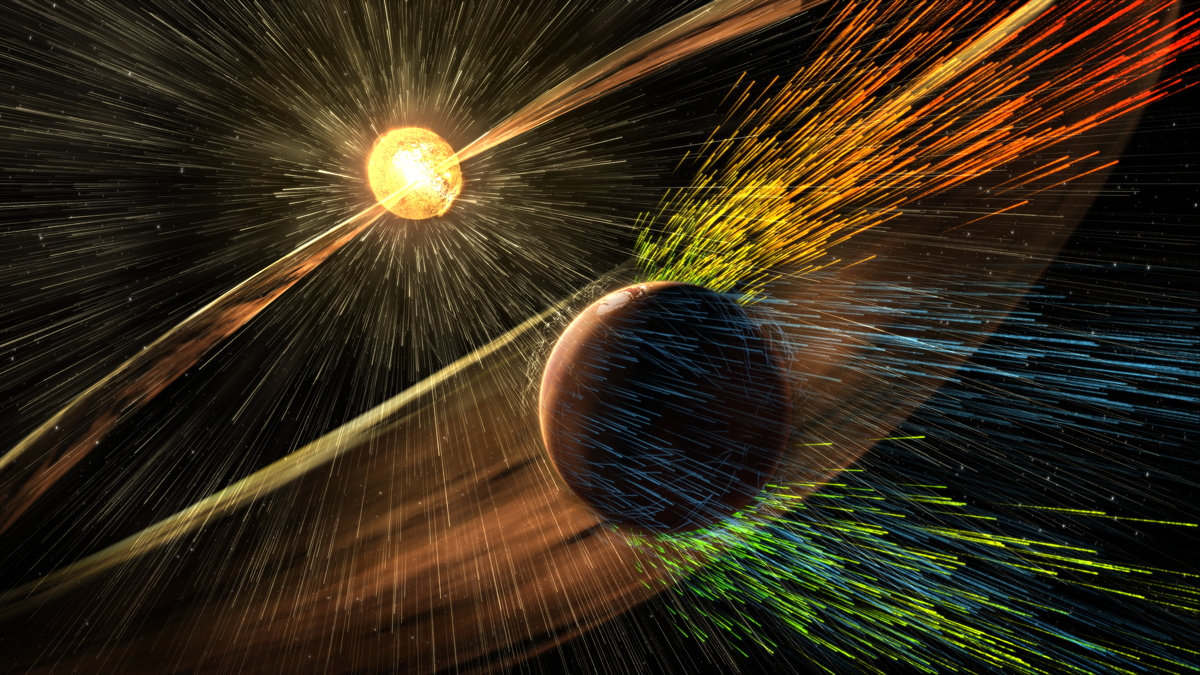Mars' Lost Atmosphere: MAVEN Probe Scientist Explains New Finding

The MAVEN spacecraft recently revealed that Mars' once-thick atmosphere was stripped away by powerful solar activity at some time in its history. Space.com talked with Bruce Jakosky, principle investigator for MAVEN, about the findings.
"MAVEN has been focused on trying to understand the changing Mars climate," Jakosky told Space.com. Geologic evidence suggests Mars was once warm enough to host oceans of liquid water on its surface, but today the planet is frigid and dry. What changed?
The new findings from MAVEN show that the Martian atmosphere was lost to space, with large amounts stripped away by strong solar activity — as opposed to the atmosphere going down into the soil. Jakosky spoke further about the new findings, and what they mean for the possibility of terraforming Mars. [NASA's MAVEN Mars Mission in Photos]

When scientists studying Martian geology realized that once upon a time, the Red Planet likely had a much thicker, warmer atmosphere, they started wondering where the atmosphere went. According to Jakosky, it could have gone up, and been lost to space, or gone down. In the latter case, the atmospheric carbon dioxide might form carbon-bearing minerals called carbonates, while atmospheric water might also have been absorbed into minerals or locked into subsurface ice. If this were the case, there should be evidence in the Martian soil.
"One of the science questions of the Mars program for the last 20 years has been to look for carbonates on the surface that would tell us that the atmosphere has gone down," Jakosky said. "And we've identified them, but in such small amounts that it can't account for an early, thick atmosphere. So now we're exploring the possibility that it went up and was lost to space."
MAVEN has shown that the Martian atmosphere is still slowly leaking into space today, but the geologic record demonstrates that the bulk of the loss likely happened in Mars' past. The new MAVEN results show that the atmosphere was likely stripped away by strong bursts of particles from the sun, known as the solar wind.

Earth's atmosphere was spared from atmospheric loss because of its protective global magnetic field, Jakosky said.
Breaking space news, the latest updates on rocket launches, skywatching events and more!
"We think that Mars did have a magnetic field early in its history, and it likely was the turning off of the magnetic field 4 billion years ago that allowed the turn on of stripping of the atmosphere by the solar wind."
Unfortunately, the leaky Martian atmosphere means it's unlikely humans could ever terraform Mars, which would require generating a new, artificially produced atmosphere.
Follow Calla Cofield @callacofield. Follow us @Spacedotcom, Facebook and Google+. Original article on Space.com.
Join our Space Forums to keep talking space on the latest missions, night sky and more! And if you have a news tip, correction or comment, let us know at: community@space.com.

Calla Cofield joined Space.com's crew in October 2014. She enjoys writing about black holes, exploding stars, ripples in space-time, science in comic books, and all the mysteries of the cosmos. Prior to joining Space.com Calla worked as a freelance writer, with her work appearing in APS News, Symmetry magazine, Scientific American, Nature News, Physics World, and others. From 2010 to 2014 she was a producer for The Physics Central Podcast. Previously, Calla worked at the American Museum of Natural History in New York City (hands down the best office building ever) and SLAC National Accelerator Laboratory in California. Calla studied physics at the University of Massachusetts, Amherst and is originally from Sandy, Utah. In 2018, Calla left Space.com to join NASA's Jet Propulsion Laboratory media team where she oversees astronomy, physics, exoplanets and the Cold Atom Lab mission. She has been underground at three of the largest particle accelerators in the world and would really like to know what the heck dark matter is. Contact Calla via: E-Mail – Twitter
